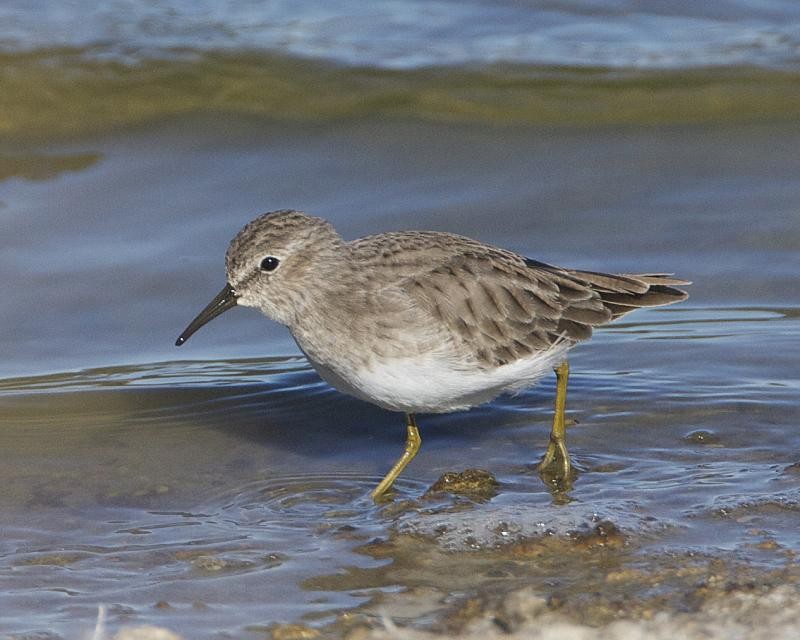Least Sandpiper
A species of Calidris Scientific name : Calidris minutilla Genus : Calidris
Least Sandpiper, A species of Calidris
Botanical name: Calidris minutilla
Genus: Calidris
 Photo By Lip Kee Yap , used under CC-BY-SA-2.0 /Cropped and compressed from original
Photo By Lip Kee Yap , used under CC-BY-SA-2.0 /Cropped and compressed from original Description
The least Sandpiper is a small shorebird that prefers gathering in groups closer to drier land while it searches for invertebrates in the sand and mud. While not common on beaches, the bird is often seen on estuaries and muddy shores. Its love for the sand means it lives up to its common name, 'Least Sandpiper'.
Size
15 cm (6 in)
Colors
Brown
Black
Yellow
White
Life Expectancy
17 years
Nest Placement
Ground
Clutch Size
3 - 4 eggs
Incubation Period
1 brood
Number of Broods
19 - 23 days
Nestling Period
1 day
Feeding Habits
Least Sandpiper primarily consume insects and other small invertebrates like amphipods, isopods, gastropods, and horseshoe crab eggs. They forage on moist mudflats, cobble beaches, and in marshes, using both sight and probing techniques. Females, with longer bills, access prey buried deeper. Least Sandpiper's diet also includes seeds from marsh grasses.
Habitat
Least Sandpiper find sanctuary primarily in wetland habitats. Preferring lower altitudes, they flourish in an array of climates from the Arctic tundra to temperate zones. Dense sedge meadows, mossy bogs, and tussock-dominated heaths characterize their breeding environments. Non-breeding habitats extend to include tidal flats, mangroves, swamps, and a variety of wetlands such as lagoons and salt marshes. Seasonal migration sees least Sandpiper occupying inland water-edged locales including muddy lake perimeters and inundated fields.
Nest Behavior
Least Sandpiper begins nesting with the male creating scrapes in the ground. The female selects one and adds lining, then they proceed with egg-laying and parental care following established patterns.
Nest Characteristics
Least Sandpiper's nest is typically situated in tufts of short marsh grass or on mossy hummocks, featuring a scrape on the ground lined with dead vegetation. The nest cup measures about 2 inches across and 1.5-2 inches deep.
Dite type
Aquatic invertebrate eater
People often ask
Migration Overview
Their breeding habitat is the northern North American continent on tundra or in bogs. They nest on the ground near water. The female lays four eggs in a shallow scrape lined with grass and moss. Both parents incubate; the female leaves before the young birds fledge and sometimes before the eggs hatch. The young birds feed themselves and are able to fly within two weeks of birth. They migrate in flocks to the southern United States, Mexico, Central America, the Caribbean, and northern South America. They occur as very rare vagrants in western Europe. 
General Info
Feeding Habits
Bird food type
Sounds
Call
Recording location: Mexico
Song
Recording location: United States
Call
Recording location: Venezuela
Behavior
Least Sandpiper exhibit notable gregariousness during migration and winter, joining flocks that may include various shorebird species. They opt for marshy roosts near foraging grounds in dispersed small clusters. Courtship is animated, with males engaging in noisy, circular flights, punctuated by vigorous wingbeats and aerodynamic glides, culminating in a dramatic dive. Territorial battles ensue as males vie for mating privileges, showcasing physicality through back-landing, foot sparring, and pursuits. Post-mating, aggression subsides, and males share incubation duties with females; however, females typically desert the brood, leaving males to guard against predators and see the young through to fledging.
Species Status
Not globally threatened.
Scientific Classification
Phylum
Chordates Class
Birds Order
Shorebirds Family
Sandpipers Genus
Calidris Species
Least Sandpiper